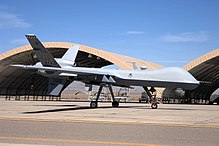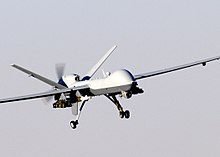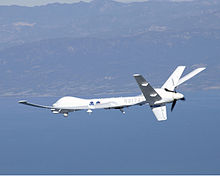General Atomics MQ-9 Reaper
| MQ-9 Reaper | |
|---|---|
| MQ-9 Reaper | |
| Role | Unmanned combat air vehicle |
| National origin | United States |
| Manufacturer | General Atomics Aeronautical Systems |
| First flight | 2 February 2001 |
| Introduction | 1 May 2007 |
| Status | In service |
| Primary users | United States Air Force U.S. Customs and Border Protection Royal Air Force Aeronautica Militare |
| Number built | 57 |
| Program cost | US$11.8 billion[1] |
| Unit cost | US$154.4 million (est 2011) system includes 4 aircraft (US$30.35 million/aircraft (2011)[1]), ground control stations, and Predator Primary Satellite Link |
| Developed from | MQ-1 Predator |
| Developed into | General Atomics Avenger |
The MQ-9 is a larger and more capable aircraft than the earlier MQ-1 Predator (other than loiter time), and it can be controlled by the same ground systems used to control MQ-1s. The Reaper has a 950-shaft-horsepower (712 kW) turboprop engine, far more powerful than the Predator's 115 hp (86 kW) piston engine. The increase in power allows the Reaper to carry 15 times more ordnance and cruise at three times the speed of the MQ-1.[2] Although the MQ-9 can fly pre-programmed routes autonomously, the aircraft is always monitored or controlled by aircrew in the Ground Control Station (GCS) and weapons employment is always commanded by the flight crew.[citation needed]
In 2008 the New York Air National Guard 174th Fighter Wing began the transition from F-16 piloted fighters to MQ-9 Reapers, becoming the first fighter squadron conversion to an all-UCAV attack squadron.[5][6][7] As of March 2011, the U.S. Air Force was training more pilots for advanced unmanned aerial vehicles than for any other single weapons system.[8]
Then U.S. Air Force (USAF) Chief of Staff General T. Michael Moseley said, "We've moved from using UAVs primarily in intelligence, surveillance, and reconnaissance roles before Operation Iraqi Freedom, to a true hunter-killer role with the Reaper
Development
With the success of the MQ-1 in combat, General Atomics anticipated the Air Force's desire for an upgraded aircraft and, using its own funds, set about redesigning Predator.Prototype "Predator B"
General Atomics began development of the Reaper with the "Predator B-001", a proof-of-concept aircraft, which first flew on 2 February 2001. The B-001 was powered by an Allied Signal Garrett AiResearch TPE-331-10T turboprop engine with 950 shp (712 kW). It had an airframe that was based on the standard Predator airframe, except with an enlarged fuselage and the wings were lengthened from 48 feet (14.6 m) to 66 feet (20 m). The B-001 had a speed of 220 knots (390 km/h) and could carry a payload of 750 pounds (340 kilograms) to an altitude of 50,000 feet (15.2 kilometers) with an endurance of 30 hours.[9]The company refined the design, taking it in two separate directions. The first was a jet-powered version; "Predator B-002" was fitted with a Williams FJ44-2A turbofan engine with 10.2 kN (2,300 lbf, 1,040 kgf) thrust. It had payload capacity of 475 pounds (215 kilograms), a ceiling of 60,000 feet (18.3 kilometers) and endurance of 12 hours. The U.S. Air Force ordered two airframes for evaluation, delivered in 2007.[10] The first two airframes delivered with prototypes B-001 and B-002 (now in the USAF museum at Wright-Patterson AFB). B-002 was originally equipped with the FJ-44 engine but it was removed and a TPE-331-10T was installed so that the USAF could take delivery of two aircraft in the same configuration.
The second direction the design took was the "Predator B-003", referred to by GA as the "Altair", which has a new airframe with an 84-foot (25.6 m) wingspan and a takeoff weight of about 7,000 pounds (3,175 kg). Like the Predator B-001, it is powered by a TP-331-10T turboprop. This variant has a payload capacity of 3,000 pounds (1,360 kg), a maximum ceiling of 52,000 feet (15.8 km), and an endurance of 36 hours.[11][12]
Version for U.S. Air Force

First MQ-9 arrives at Creech AFB, March 2007.
Operators, stationed at bases such as Creech Air Force Base, near Las Vegas, can hunt for targets and observe terrain using a number of sensors, including a thermal camera. One estimate has the on-board camera able to read a license plate from two miles (3 km) away.[13] An operator's command takes 1.2 seconds to reach the drone via a satellite link. The MQ-9 is fitted with six stores pylons. The inner stores pylons can carry a maximum of 1,500 pounds (680 kilograms) each and allow carriage of external fuel tanks. The mid-wing stores pylons can carry a maximum of 600 pounds (270 kilograms) each, while the outer stores pylons can carry a maximum of 200 pounds (90 kilograms) each. An MQ-9 with two 1,000 pound (450 kilogram) external fuel tanks and a thousand pounds of munitions has an endurance of 42 hours.[12] The Reaper has an endurance of 14 hours when fully loaded with munitions.[2] The MQ-9 carries a variety of weapons including the GBU-12 Paveway II laser-guided bomb, the AGM-114 Hellfire II air-to-ground missiles, the AIM-9 Sidewinder,[13] and recently, the GBU-38 JDAM (Joint Direct Attack Munition). Tests are underway to allow for the addition of the AIM-92 Stinger air-to-air missile.
The Air Force believes that the Predator B will give the service an improved "deadly persistence" capability, with the RPV flying over a combat area night and day waiting for a target to present itself. In this role an armed RPV neatly complements piloted strike aircraft. A piloted strike aircraft can be used to drop larger quantities of ordnance on a target while a cheaper RPV can be kept in operation almost continuously, with ground controllers working in shifts, carrying a lighter ordnance load to destroy targets.[12] In March, 2011 U.S. Department of Defense Secretary Robert Gates stated that, while manned aircraft are needed, the Air Force must recognize “the enormous strategic and cultural implications of the vast expansion in remotely piloted vehicles” that already play a major role over Afghanistan and Iraq. “The view still lingers in some corners that, once I depart as secretary and once U.S. forces draw down from Iraq and Afghanistan in accordance with the president’s and NATO’s strategy, things can get back to what some consider to be real Air Force normal,” he said. “This must not happen.” Even as it buys new manned fighters and bombers, the Air Force must give equal weight to unmanned drones and “the service’s important role in the cyber and space domains.”[8]
By October 2007 the U.S. Air Force owned nine Reapers,[14] and by December 2010 owned 57 with plans to buy another 272, for a total buy of 329 Reapers.[15] On 18 May 2006, the Federal Aviation Administration (FAA) issued a certificate of authorization that allows the MQ-1 and MQ-9 aircraft to fly in U.S. civilian airspace to search for survivors of disasters. Requests had been made in 2005 for the aircraft to be used in search and rescue operations following Hurricane Katrina but, because there was no FAA authorization in place at the time, the planes were not used.[16]
In September 2007, the MQ-9 deployed into Iraq at Balad, the largest U.S. air base in Iraq.[17] On 28 October 2007 the Air Force Times reported an MQ-9 had achieved its first "kill", firing a Hellfire missile against "Afghanistan insurgents in the Deh Rawood region of the mountainous Oruzgan province. The strike was 'successful'," the United States Central Command Air Forces said.[18]

An MQ-9 taking off in Afghanistan
The typical MQ-9 system consists of multiple aircraft, ground control station, communications equipment and links, maintenance spares, and military (or contractor) personnel. The crew consists of a pilot and sensor operator. To meet combat requirements, the MQ-9 tailors its capabilities using mission kits of various combinations of weapons and sensors payloads. The Raytheon AN/AAS-52 multi-spectral targeting sensor suite includes a color/monochrome daylight TV, infrared, and image-intensified TV with laser rangefinder/target designator to designate targets for laser guided munitions. The Synthetic Aperture Radar system enables GBU-38 JDAM targeting, is capable of very fine resolution in both spotlight and strip modes, and has ground moving target indicator capability.
Design
The typical MQ-9 system is composed of multiple aircraft, ground-control stations, satellites, and flight and maintenance crews.[21] The aircraft is powered by a 950 horsepower turboprop, with a maximum speed of about 260 knots (300 miles per hour) and a cruising speed of 150-170 knots. With a 66 foot wingspan, and a maximum payload of 3800 lbs, the MQ-9 can be armed with a variety of weaponry, including Hellfire missiles and 500-lb laser-guided bomb units.[22] The 3200 nm range of the MQ-9, and its 50,000 ft operational altitude, make it especially useful for long-term loitering operations, both for surveillance and support of ground troops.[23]Operational history
U.S. Air Force
On 1 May 2007, the 432d Wing of the U.S. Air Force was activated to operate MQ-9 Reaper as well as MQ-1 Predator UAVs at Creech Air Force Base, Nevada. The pilots first flew combat missions in Iraq and Afghanistan in the summer of 2007.[24] In October 2007 the USAF was flying operational missions in Afghanistan.[14] As of 6 March 2008, according to USAF Lieutenant General Gary North, the Reaper has attacked 16 targets in Afghanistan using 500 lb (230 kg) bombs and Hellfire missiles. On 4 February 2008 the MQ-9 dropped a bomb on a truck carrying an insurgent mortar and team near Kandahar.[25]On 17 July 2008, the Air Force began flying Reaper missions within Iraq from Balad Air Base.[26][27] It was reported on August 11, 2008 that the 174th Fighter Wing of the USAF will consist entirely of Reapers.[28] By March 2009 the U.S. Air Force had 28 operational Reapers.[29]
On 13 September 2009, an MQ-9 was flying a combat mission over Afghanistan when positive control of the aircraft was lost resulting in the drone flying out of control towards the Afghan border with Tajikistan.[30] An F-15E Strike Eagle was sent to destroy it; the Reaper's engine was disabled with an AIM-9 missile. The satellite link with the vehicle was restored immediately after, leaving the operator no option other than to steer it into a mountainside along with its ordnance. It was the first time a US drone was destroyed intentionally by allied forces.[31]
Beginning in September 2009, Reapers were deployed by the Africa Command to The Seychelles for use in Indian Ocean anti-piracy patrols.[32]
As of July 2010, 38 Predators and Reapers have been lost during combat operations in Afghanistan and Iraq, with another 9 crashing during training operations in the U.S.[33] The U.S. Air Force conducted more than 33,000 close-air-support- mission flights in 2010, an increase of more than 20 percent compared with 2009.[8] As of March, 2011, the U.S. Air Force had 48 Predator and Reaper combat air patrols flying in Iraq and Afghanistan compared with 18 in 2007.[8]
As of March, 2011, the U.S. Air Force was training more pilots for advanced unmanned aerial vehicles than for any other single weapons system.[8]
In October 2011 the U.S. Air Force began operating Reapers out of Arba Minch in Ethiopia. It has been reported that these shall be used for surveillance only operations over Somalia.[34]
NASA
NASA had initially expressed some interest in a production version of the B-002 turbofan-powered variant,[12] but instead has leased an unarmed version of the Reaper, which carries the GA-ASI company name "Altair". Altair is one of the first 3 "Predator-B" airframes. The other 2 airframes, known as "Predator-B 001" and "Predator-B 002", had a maximum gross weight of 7,500 pounds (3,400 kg). Altair differs from these models in that it has an 86-foot (26 m) long wingspan (20 feet greater than early and current MQ-9s). The Altair has enhanced avionics systems to better enable it to fly in FAA-controlled civil airspace and demonstrate "over-the-horizon" command and control capability from a ground station. These aircraft are used by NASA's Earth Science Enterprise as part of the NASA ERAST Program to perform on-location science missions.[35]In November 2006, NASA's Dryden Flight Research Center obtained an MQ-9 from General Atomics Aeronautical Systems. The aircraft has been named Ikhana and its main goal is the Suborbital Science Program within the Science Mission Directorate. NASA also acquired a ground control station in a mobile trailer.[36] This aircraft was used extensively to survey the Southern California wildfires in 2007. The data was used to deploy firefighters to areas of the highest need.
The California Office of Emergency Services requested NASA support for the Esperanza Fire, and in under 24 hours the General Atomics Altair (NASA variant of the Predator B) was launched on a 16 hour mission to map the perimeter of the fire. The Altair had just returned from a test mission a day before the Esperanza Fire started. The fire mapping research is a joint project with NASA and the US Forest Service.[37][38]
US Homeland Security
The United States Department of Homeland Security initially ordered one Reaper for border patrol duty, referred to as MQ-9 CBP-101. It began operations 4 October 2005, but on 25 April 2006, this aircraft crashed in the Arizona desert. The NTSB determined (Record Identification: CHI06MA121[39]) that the cause of the crash was most likely a pilot error by the aircraft's ground-based pilot in the use of a checklist. During its operational period, the aircraft flew 959 hours on patrol and had a part in 2,309 arrests. It also contributed to the seizure of four vehicles and 8,267 pounds (3,750 kg) of marijuana.[40] Because of these successes, a second Reaper, called "CBP-104" (initially referred to as "CBP-102"), was delivered in September 2006, and commenced limited border protection operations on 18 October 2006. The program was further expanded on 16 February 2009, including Canadian border patrols where US officials were concerned about the exploitation of the border by "drug smugglers, migrants and terrorists".[41]The CBP-101 was equipped with the Lynx SAR, AX-15 payload, ARC-210 radios, and other sensors and communications equipment; CBP-104 was enhanced with Ku band satellite command and control link and MTS-A EO/IR sensors.[40]
The President’s FY 2006 Emergency Supplemental budget request added $45 million for the Reaper program, and the FY 2007 Homeland Security Appropriations bill adds an additional $20 million. In October 2006, GA-ASI announced a $33.9 million contract to supply two more Reaper systems by Fall 2007.[42]
U.S. Customs and Border Protection has six operational MQ-9s.[43] In 2009, one was based in North Dakota, at the UAS Operations Center in Grand Forks, four in Arizona, at the UAS Operations Center in Sierra Vista and one based at Fort Drum, New York.[44] The aircraft are equipped with GA-ASI's Lynx Synthetic Aperture Radar (Lynx SAR info/web page) and Raytheon's MTS-B ElectroOptical/Infrared sensors.[45]
On 25 April 2006, an MQ-9 operated by U.S. Customs and Border Protection crashed near Nogales, Arizona. The pilot, remotely operating the vehicle from Sierra Vista Municipal Airport, reported a momentary lockup of the displays on the primary control console. The pilot switched control to a secondary console, and in doing so inadvertently shut down the vehicle's engine, causing it to descend out of reach of communications and ultimately crash.[39][46]
Testbed
The Reaper is being used as a testbed for Gorgon Stare, a wide-area surveillance sensor system.[47]Non-US use
Australia
In September 2006, the General Atomics Mariner demonstrator aircraft was operated by the Australian Defence Science and Technology Organisation (DSTO) in an exercise designed to evaluate the aircraft's ability to aid in efforts to stem illegal fishing, drug running and illegal immigration. The Mariner operated from RAAF bases Edinburgh, South Australia and Learmonth, Western Australia in conjunction with a Royal Australian Navy Armidale class patrol boat, the Joint Offshore Protection Command and the Pilbara Regiment.[48]United Kingdom
On 27 September 2006, the U.S. Congress was notified by the Defense Security Cooperation Agency that the United Kingdom was seeking to purchase a pair of MQ-9 Reapers. They are operated by No. 39 Squadron RAF from Creech Air Force Base, Nevada.[49] A third MQ-9 was in the process of being purchased by the RAF in 2007.[49] In December 2010, the UK Ministry of Defence announced that it would increase its fleet of Reapers to 10.[50]On 9 November 2007, the UK Ministry of Defence announced that its MQ-9 Reapers had begun operations in Afghanistan against the Taliban.[51] In April 2008, following the crash of one of the UK's two Reapers, British special forces were sent to recover sensitive material from the wreckage before it was blown up to prevent the enemy from obtaining it.[52]
Germany
Germany has made a request to purchase five Reapers and four ground control stations, plus related support material and training. The request, being made through the Foreign Military Sales process, was presented to Congress through the Defense Security Cooperation Agency on 1 August 2008 and is valued at US$205 million.[53][54] However, Germany did not go through with this procurement for the time being and decided to lease the IAI Heron offered by IAI and Rheinmetall instead, initially for the duration of one year, representing a stop-gap measure before a long-term decision on a MALE-system is being made.[55][56][57][58]Italy
On August 1, 2008, Italy submitted a FMS request through the Defense Security Cooperation Agency for four aircraft, four ground stations and five years of maintenance support, all valued at US$330 million.[53][59] Italy ordered two more aircraft in November, 2009.[60]Variants
General Atomics designed a naval version of the Reaper, named the "Mariner", for the U.S. Navy's Broad Area Maritime Surveillance (BAMS) program requirements. The design would have an increased fuel capacity in order to have an endurance of up to 49 hours.[61] Proposed variations on the ultimate design included one designed for carrier operations with folding wings for carrier storage, shorter and more rugged landing gear, an arresting hook, cut-down or eliminated ventral flight surfaces and six stores pylons with a total load of 3,000 pounds (1,360 kilograms).[12] The Northrop Grumman RQ-4N was announced the BAMS winner.
The US Customs and Border Protection has ordered a "Maritime Variant" of the MQ-9.[62]
Operators
- Turkish Air Force (Turkey initially ordered four aircraft and three command centers)[64]
- United States Air Force
- U.S. Customs and Border Protection
- Sierra Vista, Arizona
- Grand Forks, North Dakota
Specifications
| This aircraft article is missing some (or all) of its specifications. If you have a source, you can help Wikipedia by adding them. |
- Sources: USAF Fact Sheet,[67] Globalsecurity.org[68]
- General Characteristics
- Crew: None onboard (controlled remotely by pilot and sensor operator)
- Landing Type: runway
- Launch Type: runway
- Length: 36 ft (11 m)
- Wingspan: 66 ft (20 m)
- Height: 12.5 ft (3.6 m)
- Empty weight: 4,900 lb (2,223 kg)
- Fuel Capacity: 4,000 lb (1,800 kg)
- Max takeoff weight: 10,500 lb (4,760 kg)
- Power Plant: Honeywell TPE331-10 turboprop engine, 900 shp (671 kW), with Digital Electronic Engine Control (DEEC)[69]
- Performance
- Maximum speed: 260 knots (482 km/h, 300 mph)
- Cruise speed: 150–170 knots (276–313 km/h, 172–195 mph)[70]
- Range: 1000 nautical miles (1850 km)[71]
- Endurance: 14–28 hours (14 hours fully loaded)[72]
- Payload: 3,800 lb (1,700 kg)
- Internal: 800 lb (360 kg)
- External: 3,000 lb (1,400 kg)
- Service ceiling: 50,000 ft (15 km)
- Operational altitude: 25,000 ft (7.5 km)[73]
- Sensors
- Armament
- 7 hardpoints
- Up to 14 AGM-114 Hellfire air to ground missiles can be carried or four Hellfire missiles and two 500 lb (230 kg) GBU-12 Paveway II laser-guided bombs. The 500 lb (230 kg) GBU-38 Joint Direct Attack Munition (JDAM) can also be carried. Testing is underway to support the operation of the AIM-92 Stinger air-to-air missile.

















0 Comment:
Posting Komentar